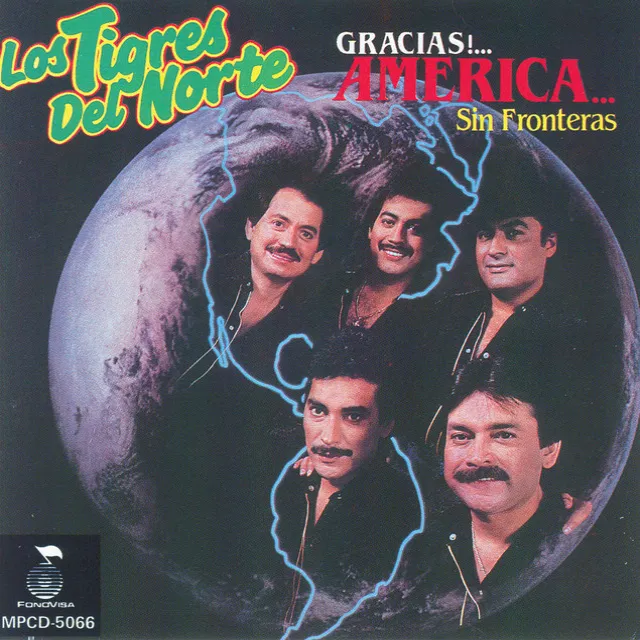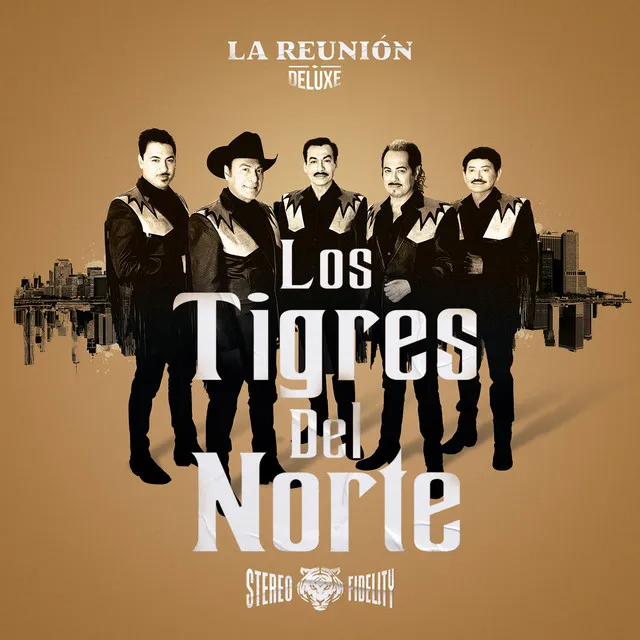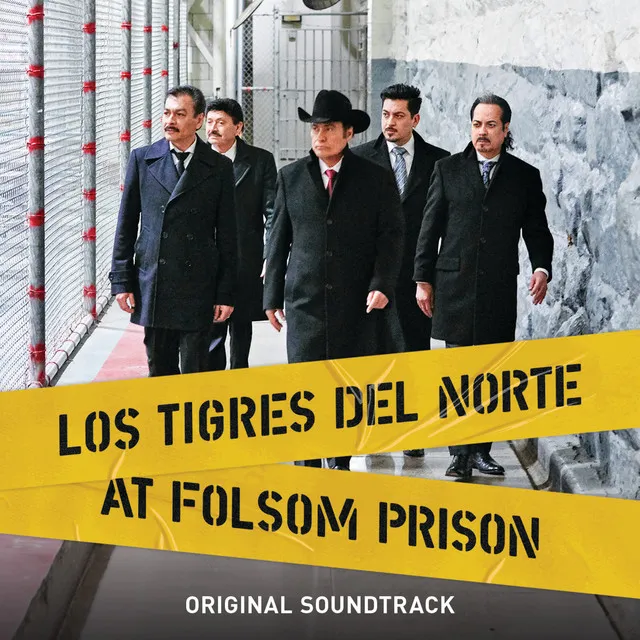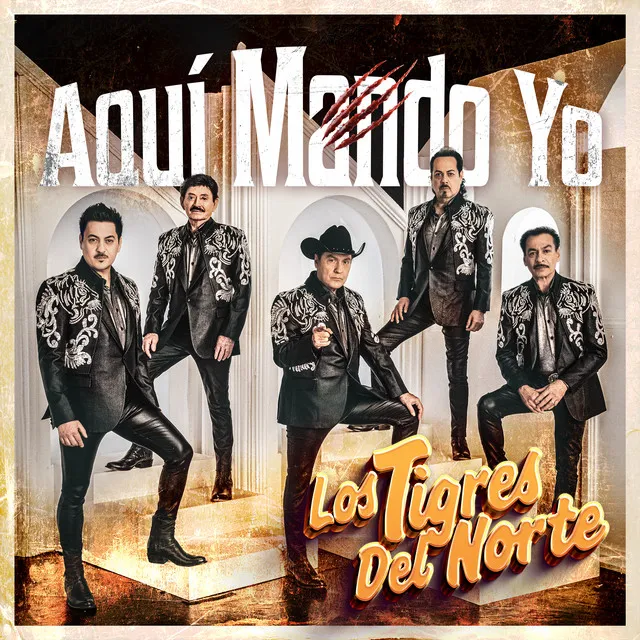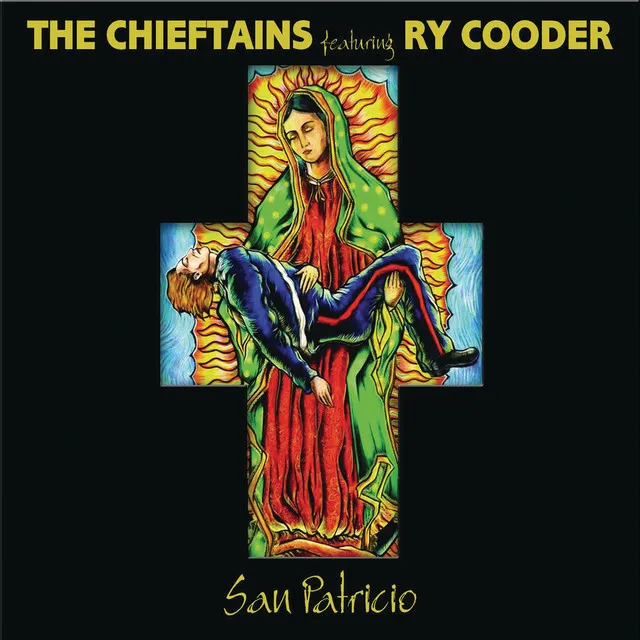Los Tigres del Norte are an internationally successful norteño group from Mexico based in California. Since the late 1960s, this family band has detailed the struggles and triumphs, romances, and heartbreaks of working people, families, immigrants, outlaws, politicians, and farmers. Over more than 70 albums -- including 22 number ones -- they turned norteño, an accordion-based polka music indigenous to Northern Mexico, into commercially viable pop music, infusing the tradition with boleros, cumbias, rock rhythms, waltzes, and sound effects. Their 1974 breakthrough single, "Contrabando y Traición," about a drug deal and love story gone bad, sold on both sides of the border, establishing them in the U.S. 1984's Jaula de Oro was their first chart-topper. The following year's A Ti Madrecita marked their first million-seller. 1989's Corridos Prohibidos kicked off the modern narcocorrido movement, paving the way for the 21st century's alterna-movimiento. 2011's MTV Unplugged is among the series' most successful volumes, and 2014's number one Realidades discussed the harsh realities of immigrants. In 2019, Los Tigres del Norte were the first musical act since Johnny Cash to film a concert at Folsom Prison. In 2021 they issued Y Su Palabra Es La Ley: Homenaje A Vicente Fernandez and followed it with La Reunion in 2022.
The group is centered on lead vocalist and accordionist Jorge Hernández (the oldest of 11 children), who is joined in Los Tigres by his brothers Hernán (bass, vocals), Eduardo (accordion, saxophone, bass, vocals), and Luis (bajo sexto, vocals) -- he replaced older brother Raul Hernandez who'd left to pursue a solo career during the 1990s -- and cousin, Oscar Lara (drums).
Their parents were campesinos, small farmers who worked the land with ox-drawn plows. The Hernandez family lived and worked in Rosa Morada, a tiny village located in the municipality of Mocorito in Sinaloa.
Jorge still insists that the day his grandmother brought home a Philco radio changed the course of his family's lives. It was the only electronic device of its kind. Amid the region's hilly terrain it managed to pull in just one radio station -– a 150,000-watt powerhouse from Harlingen, Texas -- that played pure norteño music exclusively. Jorge heard the music of major norteño artists including Freddie Gómez, Los Donneños, and Los Dos Gilbertos, for the first time. The acts were already making money across the border, and were known only in the United States at the time.
During festivals, locals would set up a Victrola with a bullhorn for a speaker. At these parties, the Hernandez brothers were introduced to other top norteño acts including Los Alegres de Terán, and national mariachi stars including Pedro Infante. Aside from commercial music, they picked up songs from the oral traditions older men in town taught them. They taught the boys the revolutionary-era corridos about bandits and rebels, horses and heroes. The youngsters memorized verse after verse about historic and folkloric figures including Pancho Villa and learned to play as a band. These songs truly inspired Jorge, who desperately wanted to become a professional singer and songwriter.
In 1966, their father, D. Eduardo Hernández, suffered a tragic accident causing a serious back injury that left him unable to walk. The youngsters, still young teens, started playing local gigs at night to earn money for their father's medical bills. Pressed by financial necessity to earn even more, they moved to the border town of Mexicali and worked its bar and restaurant circuit quite successfully. They eventually hired a manager and bought a van so they could work all across town from noon to dawn. In Mexicali they caught the break that would change their lives -- and ultimately, norteño music.
One day, a telegraph worker Jorge knew form sending money home, told him that a promoter in San Jose, California, had put the word out that State officials were looking for Spanish-language acts to entertain Mexican inmates at Soledad prison. The gig didn't pay, but it provided exposure. With a 90-day visa, they could look for additional gigs in the U.S. After an audition, the Hernández brothers were hired as part of a revue brought in for the prison show.
While filling out their visas and working papers, a U.S. immigration agent asked what the group's name was, but they didn't have one. The border officers affectionately referred to boys who exhibited a "go-get-em" attitude as “little tigers.” Since they were headed north, the agent dubbed them the "Little Tigers of the North," then eliminated the diminutive so they wouldn’t outgrow the name and Los Tigres del Norte were born. After the Soledad performance they got stranded in San Jose, but it proved a fateful break. They played clubs and cantinas, and even on radio station KOFY.
They were discovered by Englishman, producer, and promoter Art Walker. Los Tigres del Norte became the first act signed to his Fama Records, which grew to become the leading Spanish-language record label on the West Coast. Walker, a local impresario, first heard the group on a live radio presentation recorded at the local Parque de las Flores on Keyes Street in San Jose and, impressed with what he heard, decided to make them Fama's core band. With his guidance, Los Tigres adopted an electric style, trading in their traditional acoustic sound for one incorporating bass, drums, and electric guitar. The group also adopted a modern approach to songwriting, emphasizing contemporary social themes common to Mexican-Americans. They cut the single "De un Rancho a Otro," and in 1968 issued their debut long-player, Juana La Traicionera/Por el Amor a Mis Hijo. While it got local airplay in San Jose, and in Sinaloa, it didn't sell many copies. Neither did 1969's Sufro Porque Te Quiero/La Cochicuina or 1970's Si Si Si: Chayo Chaires. That said, the continued wave of releases presented them with opportunities to tour.
In late 1971, Jorge and Walker heard a corrido singer in Los Angeles play "Contrabando y Traición" about a drug-smuggling couple whose exploits end in betrayal and murder. It hit at radio and eventually charted in both the U.S. and Mexico, creating the modern narcocorrido subgenre. The followed with "La Banda del Carro Rojo," about a drug-smuggling gang in a red car. It too charted.
Both songs became sizable hits in Southern California and in Mexico. They issued Contrabando y Traicion, their first charting album (and sixth overall) in 1974. Between 1976's Pueblo Querido and 1980's En La Plaza Garibaldi, they cut eight albums for Fama, but were paid for none of them. Los Tigres del Norte made their money playing live and by selling wholesale copies out of their van. While their recordings did reasonably well and kept concerts full, the band saw its profile grow exponentially when they appeared in the 1976 films La Banda Del Carro Rojo and La Muerte Del Soplon -- both were based on their corridos.
The band sued Walker and won their freedom from Fama as well as the rights to their recordings. For several years they recorded for a variety of labels including EMI Pops, Profono Internacional, and Golondrina. Beginning with 1984's Jaula de Oro, the group would regularly score big on the Regional Mexican album chart stateside, and this success was acknowledged in 1987 when they won their first Grammy Award for Best Mexican-American Performance, for Gracias America...Sin Fronteras (1986) topping the Mexican Regional charts.
They signed with Fonovisia in late 1987, and released their label debut, Ídolos Del Pueblo in 1988. They also appeared in three films based on their songs: La Puerta Negra (1986), La Jaula De Oro (1987), and Tres Veces Mojado (1989). 1988's Gracias! ... América ... Sin Fronteras topped the charts and spent more than 73 weeks on the charts; it earned Los Tigres del Norte their first Grammy award. In 1989 they issued two Grammy-nominated albums that reached the upper rungs of the charts, Mi Buena Suerte went to number three, while Los Corridos Prohibidos went to number one. Their first album with saxophonist brother Eduardo Hernandez, it marked the flowering of the narcocorrido movement. Despite an intense recording schedule, they never stopped touring or consciously building their fan base. Not only did they play across Mexico and North America, they made inroads to the rest of Latin America as well, consciously keeping ticket prices low.
The next two decades saw Los Tigres del Norte tour for 1991's Para Adoloridos and Incansables -- both albums made the Top Five -- while 1993's La Garra De went Top 20. Tragedy was in the offing, however: Brother and percussionist Freddy Hernandez died after a heart attack suffered in a hotel room on tour. 1994's now historic Los Dos Plebes went to number two, largely based on its single "Muerte Anunciada," a legendary narcocorrido about the life and death about Colombian drug kingpin Pablo Escobar. 1995's El Ejemplo reached number two at Mexican Regional Albums but more change was in the air: Bajo sexto player Raul Hernandez announced his departure for a solo career after completing the support tour. He later revealed that part of the reason for leaving was feeling that tracks such as "Muerte Anunciada" and other narcocorridos glorified drug traffickers; none of the group's other members shared that opinion.
Throughout the '90s, the band's fortunes multiplied. They were playing larger venues and touring abroad. They sold out concerts across Central and South America while playing football stadiums in Mexico and concert halls in the United States as the hits kept on coming. The appeared in four more films including Amor a la Medida, a romantic musical drama directed by Raúl Araiza. 1996's Unidos Para Siempre topped the Mexican Regional Albums chart. 1997's Jefe de Jefes followed it but also became their first entry in the Top 200. The album also topped the Latin Albums chart and earned a Grammy nomination. The following year's more romantic Asi Como Tu became their third straight number one at Mexican Regional Albums. Los Tigres del Norte closed the century with Herencia de Familia. It not only topped the Mexican Regional charts but fought its way into the top half of the Top 200.
The band's popularity only grew in the 21st century. In 2000, De Paisano A Paisano became their fifth consecutive number one at Regional Mexican Albums; it also cracked the front half of the Top 200. 2001's Uniendo Fronteras reached the top spot on the Mexican Regional list.
The title track of 2002's La Reina del Sur (Queen of the South) was based on Spanish author Arturo Perez-Reverte's novel about Teresa Mendoza, a Mexican woman who becomes a trafficker and emigrates to Spain where she becomes one of the most feared and respected gangsters of all time. The track met with great resistance from Mexican radio as the country's government censors pressured Latin radio stations in Mexico and the U.S. to refrain from playing it. Ultimately it made no difference. It topped Latin albums and Mexican Regional charts and went to number 54 on the Top 200. The single reached number nine on Hot Latin Songs. The full-length was nominated for a Grammy award. Further, both the song and the novel inspired the 2011 Netflix series of the same title, starring Kate del Castillo in the lead role.
The group were honored with El Mas Grande Homenaje a Los Tigres del Norte (2001), a tribute album featuring many of the biggest names in Mexican music including Julieta Venegas and Molotov. Furthermore, beginning in 2003 Fonovisa began to compile a series of greatest-hits compilations titled Herencia Musical. The first, Herencia Musical: 20 Corridos Inolvidable, unsurprisingly, went to number one. 2004's Pacto de Sangre also reached the top spot on the Mexican Regional albums chart and the upper half of the Top 200; it was followed by the cumbia offering Cumbias Y Algo Mas.... that peaked at three.
Throughout their long and storied career, Los Tigres maintained a respectable image, never glamorizing the drug trade nor any other criminal activity. They refused to be photographed with so much as a gun in sight. This air of respectability helped expand their audience demographically and internationally.
During the new century's first decade, Los Tigres global concerts more often than not reflected the diversity of their fan base. Amid all of the touring and recording activity, they continued releasing albums on an annual basis and branched out into cinema as well, with DVD videos becoming a regular addition to their music releases. In 2006, Fonovisa reissued some of the band's films on DVD, including La Banda del Carro Rojo and La Muerte del Soplon -- with thematic compilations of Los Tigres favorites. That same year they issued the covers album Raices. It topped the Latin albums and Mexican Regional charts and went to number 68 on the Top 200. It also won the Grammy for Best Norteño Album. Two years later the band made the film La Misma Luna, a 2007 bilingual Mexican-American drama directed by Patricia Riggen about the plight of a mother and son after illegally entering El Norte. The band also took home another Grammy for the live audio/visual offering Tu Noche Con Los Tigres Del Norte.
2009's La Granga, offered a balance of songs about immigration, romance, and narcocorridos,. It topped the Mexican and Latin albums lists and went to number 45 on the Top 200. Certified multi-platinum, it became Los Tigres del Norte's highest-charting album. In 2011, Diego Torres, Zack de la Rocha, Andrés Calamaro, and others would assist the group in celebrating their long career on the spirited MTV Unplugged: Los Tigres del Norte and Friends. One of the best-selling volumes in the series, it topped various charts and won a Grammy for Best Banda or Norteño Album.
After a four-year break from studio recording, Los Tigres del Norte issued the full-length Realidades in October of 2014. It was their 23rd album to reach the Top Ten on the Top Latin Albums chart, tying the record originally set by Los Temerarios. The album entered at number three. It won a Grammy for Best Regional Mexican Music Album (including Tejano) two years after its release. On November 13, 2015, the group released the single "Tu Carcel," written by Marc Antonio Solis (who appears on it), an artist Los Tigres consider the "poet of the century." It was followed three weeks later by the live album Desde al Azteca.
In 2016, Los Tigres del Norte, like many musicians before them, submitted a request to perform at California's Folsom Prison. It took two years to get permission, but on the 50th anniversary of the norteño legends playing their very first show in the United States at Soledad prison, they received said permission to play Folsom. They played the show in mid-April 2019, marking the first time a major act performed at the prison since Johnny Cash took its stage nearly half-a-century before. Los Tigres made it special for the inmates, and even brought one of them on-stage to play accordion on their reading of the Cash classic, "Folsom Prison Blues." Both album and film were released in September 2019.
The following year, Los Tigres del Norte released Y Su Palabra Es La Ley: Homenaje a Vicente Fernández, a 15-song tribute to the legendary mariachi and ranchera singer. They combined ranchera, mariachi, and corrido styles in reading 14 songs closely associated with the great vocalist, and added the unpublished corrido "Un Consentido de Dios," composed especially for him. Fernandez died the following year at age 81. Los Tigres del Norte released the six-track La Reunion EP digitally in 2021, followed by a deluxe edition that doubled its track length and received a physical release in May 2022. ~ Jason Birchmeier & Thom Jurek, Rovi
